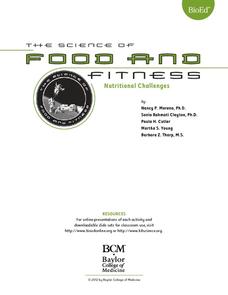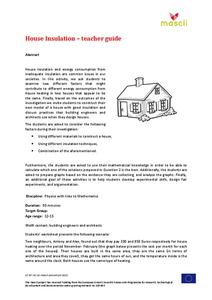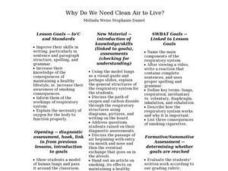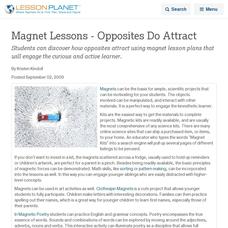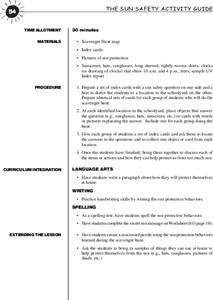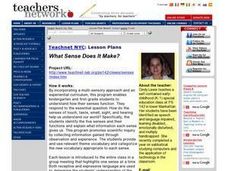West Contra Costa Unified School District
Scientific Method Mania
Horrible science puns only happen periodically, but the scientific method is forever. Young scientists observe two presentations on the scientific method, complete independent practice worksheets, and integrate their knowledge through a...
Perkins School for the Blind
Polyatomic Ion Bingo
If your class is learning about polyatomic ions and needs a fun way to study those chemicals, then a bingo game might be right up your alley. This bingo game is intended to boost memorization skills, specifically the names of tricky...
BioEd Online
Nutritional Challenges
Eating healthy can be a challenge, especially for people with special dietary needs. After learning about standard nutritional needs for adults, learners take on the role of a dietician and work together to create a menu for one of the...
Magic of Physics
Electric Circuits
Teaching about circuits can be as easy as flipping a switch! Science scholars explore the world of electricity using a fun interactive. The resource uses drag-and-drop images to promote an understanding of circuit components, types of...
California Academy of Science
Global Climate Change and Sea Level Rise
Ice is nice, and its condition on the planet has a significant effect. Junior geoscientists experiment with ice melting in both water and on land to discover how each affect the rising sea level. This detailed instructional activity...
National Geographic
Measuring Elevation Past and Present
After viewing a short video about a climb up Mount Everest, high schoolers read about triangulation for measuring distant elevations. Have your class work in groups to construct an inclinometer and then use it to measure the height of...
Curated OER
4-H Food Science- Intermediate Activity
In this nutrition worksheet set, students complete a dinner detective nutrient fill in the blank, a food safety true or false page, and plan a picnic with food safety rules in mind. They investigate careers that involve food safety.
WakeGOV
Plastic Sight Words
Plastic math? Have young learners count and name the number of plastic items in their centers. Kindergartners match sight word cards to the number of plastics in a given group, while learning that plastics come in all different shapes,...
Mascil Project
House Insulation
Make sure your house is warm in the winter. Pupils analyze graphs of heating costs for two similar houses and make hypotheses for why the costs differ. They then build models of houses with appropriate insulation to reduce heating costs.
Curated OER
Uses of Coal
An interesting series of puzzles and word games are available in this multi-page collection, which focuses on coal. Learners practice math and language arts skills as they solve the puzzles, and learn many facts about coal at the same time.
Curated OER
Keeping Your Heart in Good Shape: What are the Benefits? - Biology Teaching Thesis
Students name the main parts of the heart and what events occur there. They write a reaction that contains complete sentences, and uses proper spelling and grammar, after viewing a video. Students define the following terms: contraction,...
Curated OER
Tomato Exploration
Create tomatoes in 15-20 minutes using this fun and interactive lesson plan! Learners listen to a book about tomatoes (recommendations listed), and focus on the vocabulary word tomato. They count the syllables...
Curated OER
Why Do We Need Clean Air to Live? - Biology Teaching Thesis
Students name the main components of the respiratory system. They write a reaction that contains complete sentences, and uses proper spelling and grammar, after viewing a video. Students define the following terms: lungs, respiration,...
California Academy of Science
The Heat is On: Cause and Effect and Climate
The higher the number of letters in the final word for the National Spelling Bee, the higher the number of people killed by venomous spiders. Obviously, those two facts correlate, but no causation exists. Scholars view data based on...
Nuffield Foundation
Dissecting Lungs
Here is a lab activity where teens experience the respiratory system first-hand as they dissect lungs and identify key structures within the system. Although the website is written in British English with some slightly different verbiage...
Curated OER
The Heart of the Matter
Upper elementary pupils learn about the blood transportation system and anatomy of the human heart. They fill in an outline of the human heart (not included) focusing on the flow of blood to and from the heart. Using stethoscopes,...
Curated OER
Comparing the Amoeba to Paramecium
This laboratory activity is valuable practice in comparing features of different organisms. You could use it to introduce junior biologists to protozoans. The materials and procudures for the learners are simple, and analysis...
Curated OER
Magnet Lessons - Opposites Do Attract
Students can discover how opposites attract using magnet lesson plans that will engage the curious and active learner.
Curated OER
Name Scramble
In this name scramble worksheet, learners practice unscrambling the names of ten reptiles and amphibians for spelling mastery of these animals.
Curated OER
The Sun Safety Activity Guide
Students participate in a scavenger hunt to examine the importance of sun safety. They answer questions from index cards and if they answer correctly they move to a different station. They write a paragraph on how to protect themselves.
Curated OER
Label Your Body
Students assimilate the names of the parts of the body. They practice spelling body part words using a worksheet. They trace the outline of their bodies, add features and label the body parts from the vocabulary list.
Curated OER
IDENTIFYING PARTS OF THE BODY
Pupils identify and describe the various parts of the body therefore, practicing English vocabulary, pronunciation, and spelling. They discuss the various body parts, some of the inner organs and also, their functions. Finally, students...
Curated OER
SAY IT WITH DNA: Protein Synthesis Tutorial
Ninth graders explore protein synthesis. In this DNA lesson students complete a worksheet and a DNA lab activity.
Curated OER
What Sense Does It Make?
Students identify the five senses and their functions and explain what information each sense gives us. They collect information gained through observation and experiences. They practice identifying new vocabulary words from the word wall.


